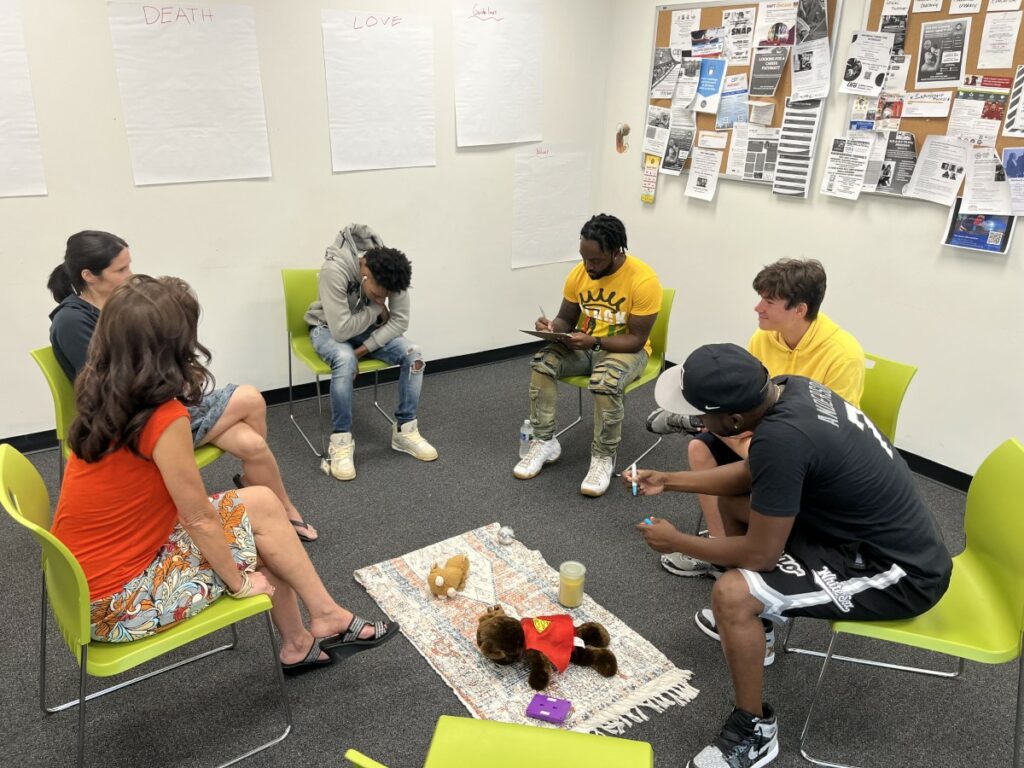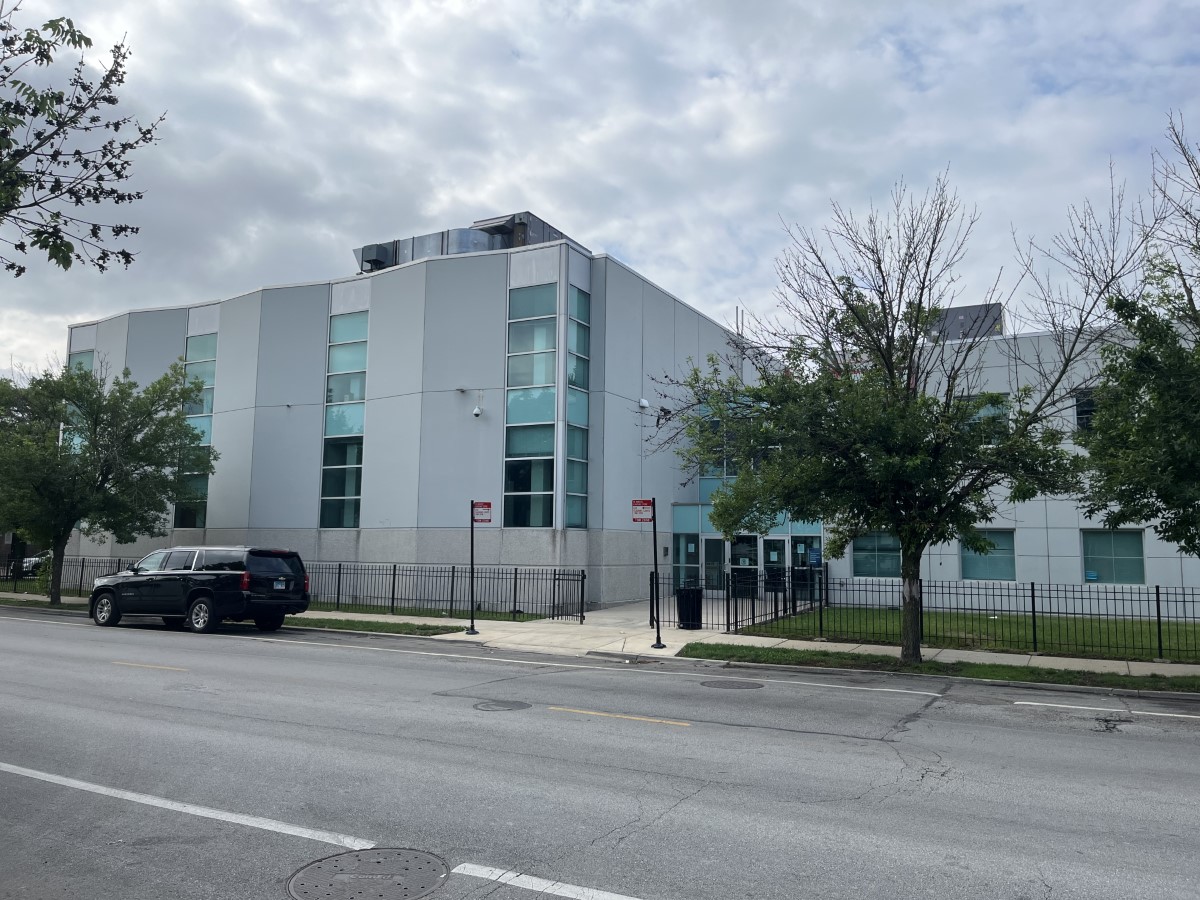A couple blocks west of 69th Street and Halsted Avenue, in a large, nondescript Salvation Army office building, the Restorative Justice Community Court (RJCC) of Englewood is changing the status quo. Englewood’s RJCC works with participants from select South Side zip codes to divert young people charged with nonviolent crimes away from the criminal legal system and towards a second chance.
This location is one of three restorative justice courts in Chicago—the others being in North Lawndale for West Side participants and Avondale for North Side participants—that are part of a relatively recent program started by the Circuit Court of Cook County and overseen by the Office of the Chief Judge, Timothy Evans.
Unlike the criminal justice system, which employs punishment via incarceration, restorative justice holds that violence, and other legal or normative violations, are best addressed by bringing together those most affected by the harm, including the wider community, to discuss what should be done to repair that harm. The practice is related to but different from transformative justice, which contends that the oppressive structures giving rise to harms must be addressed first and foremost.
Restorative justice has gained traction as an alternative to addressing harm. In recent years, Chicago Public Schools, for instance, have replaced School Resources Officers in certain high schools with deans of culture who are responsible for implementing restorative practices.
Advocates claim that their introduction will limit the school-to-prison pipeline by shifting away from the zero-tolerance model of discipline. That model often resulted in the disproportionate suspension and expulsion of Black and brown students, especially boys, leading them to drop out of the educational system entirely and fall into the criminal legal one. Restorative conversations led by trained practitioners and with teachers and other students participating promise different outcomes.
Though the RJCC is across the hall from a probation office, there are subtle ways in which the RJCC distinguishes itself from a traditional courtroom setting.
Since 2020, when it launched, the court has met in a prototypical office space—bright fluorescent lights overhead, white gypsum ceiling panels, and gray carpeting. It’s quite dissimilar from the august, impressive courtrooms of the Leighton Criminal Courthouse on 26th St. and California Ave. where judges preside from raised wooden benches, peering down on counsel and defendants alike, while spectators struggle to make out the proceedings from behind protective bubble glass.
Along the walls of the RJCC, where in traditional courtrooms portraits of U.S. presidents might hang, are instead posters of Malcolm X and Angela Davis bearing inscriptions with inspirational quotes: “There is no better teacher than adversity,” and “We must always attempt to lift as we climb,” respectively. On the far wall, a green Sankofa bird picks up an egg in its mouth, representing the retrieval of ancestral knowledge, near where an American flag would likely stand as a symbol of the power and authority of the state.
Donna Cooper is acting presiding judge of the Juvenile Justice Division of the Circuit Court of Cook County, situated at 2245 W. Ogden Ave. on the Near West Side, but she spends her Wednesdays at Englewood’s RJCC, reviewing blue case folders from a large neat stack.
She is easy to miss seated at the square arrangement of tables, surrounded on all sides by the various persons who normally fill in a courtroom—a stenographer, a public defender, a couple of clerks—and some who do not, like the RJCC coordinator Marlo Norman and the RJCC case manager Craig Carrington.
A small woman, Judge Cooper doesn’t wear black robes or beat a gavel while overseeing proceedings at the RJCC. On this particular Wednesday she wore a powder blue pantsuit, a multi-colored scarf, and dangly earrings. Her toes poked out of light blue slides that matched her outfit.
Cooper grew up in Englewood and hasn’t strayed far from Chicago in the years since. She attended Northwestern University in Evanston for her bachelor’s degree and then completed her juris doctorate at DePaul University. First elected as a judge in November 2008, Cooper has been called by Chief Judge Timothy Evans, “an excellent judge who understands the importance of helping troubled young people become good citizens.”
The cases tended to follow certain patterns. Most of the participants, who were read into the record without their presence in the room, were male, young, and facing criminal charges for the first time, typically for unlawful use of a weapon or possession of a stolen motor vehicle.
Carrington, the case manager, confirmed that these were the kinds of nonviolent felony or misdemeanor offenses the RJCC takes. Participants range in age from eighteen to twenty-six, and once they go through the restorative program—which involves participating in four to six peace circles, financial literacy and gun safety courses, and mentorship and community service programming—the State’s Attorney’s Office agrees to drop the charges against them, and they can file to expunge their criminal record with the help of Teamwork Englewood.
This is what attracts many of the nearly sixty participants involved in the Englewood RJCC’s program.
Heidi Hornemann, a private defense attorney, said she seeks to transfer her clients to the RJCC system whenever possible. Though she’s only been working with the program for the past nine months, she thinks that it’s been helpful for her clients.
“They get a second chance, and they don’t have to go through the stress of fighting a case in court,” she said.
Hornemann also commended the collaborative nature of the RJCCs, where the purpose is for participants to get out of the system, instead of the adversarial proceedings in criminal courts, where prosecutors battle defense attorneys for defendants to get the maximum possible sentence.
The RJCC programs are still small. The RJCC programs are still small. Between the three courts, only eighty-two participants are currently involved. And they are limited to people living in one of a select number of zip codes in Cook County.
Fred Cooper is a practiced and nonjudgmental steward of the peace circles. Cooper, forty, who grew up in Chatham and has lived in Englewood for the past 10 years, has been leading peace circles for the past eight years. He and Javion Reed are the peace circle keepers at the RJCC in Englewood.
Cooper got involved in peace circles after a stint in Cook County Jail himself, an experience that helps him relate to the youth. “I was really drawn to the approach,” he said, “because we sit in this space where a lot of people who don’t have a voice, now [have] a space where everybody has a voice.”
“What motivates me,” he continued, “is the people that I work with, the cases that get dismissed, the lives that get changed, the relationships that I build.”

Derived from Indigenous and African practices, Reed explained, the peace circle has a central rug, a talking stick, and a candle. Each is a symbol—the different colors on the rug represent the different points of view of the participants involved; the talking stick, which is passed only to the left, signifies the respect and attention that must be conferred on the speaker; and the candle acts as a bonding device.
Cooper and Reed’s intimate knowledge of the lives and experiences of their participants helps break down the formidable barrier of their skepticism. “Most of them start off slow, especially at the first circle,” Cooper said. “But as they start to get to know me better and know the process better, that’s when they open up.”
Demarcus M., their first participant of the day—they typically see three to five, depending on how many show up for their scheduled sessions—seemed initially wary of the peace circle process. His arms were crossed and he wasn’t particularly talkative when holding the talking piece. But as the hour-plus conversation proceeded, and Cooper related aspects of his own upbringing to Demarcus’s, his arms dropped and he spoke enthusiastically.
By the third circle, Cooper expects Demarcus to be more comfortable, to let his guard down and reveal more about himself.
When asked why he agreed to participate in the RJCC program even though it was unfamiliar, Demarcus neatly stated the goal himself: “If you don’t take accountability, how can you change?”
Max Blaisdell is an educator and basketball coach based in Hyde Park. He is originally from New York City and later served in Peace Corps Morocco. He last covered a panel connecting abolition in Chicago with demilitarization. He’s also a staff writer at the Hyde Park Herald.

